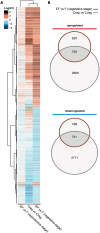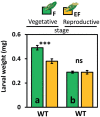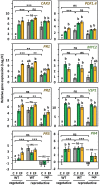Priming of Arabidopsis resistance to herbivory by insect egg deposition depends on the plant's developmental stage
- PMID: 35522985
- PMCID: PMC9366327
- DOI: 10.1093/jxb/erac199
Priming of Arabidopsis resistance to herbivory by insect egg deposition depends on the plant's developmental stage
Abstract
While traits of plant resistance to herbivory often change during ontogeny, it is unknown whether the primability of this resistance depends on the plant's developmental stage. Resistance in non-flowering Arabidopsis thaliana against Pieris brassicae larvae is known to be primable by prior egg deposition on leaves. We investigated whether this priming effect is maintained in plants at the flowering stage. Larval performance assays revealed that flowering plants' resistance to herbivory was not primable by egg deposition. Accordingly, transcriptomes of flowering plants showed almost no response to eggs. In contrast, egg deposition on non-flowering plants enhanced the expression of genes induced by subsequent larval feeding. Strikingly, flowering plants showed constitutively high expression levels of these genes. Larvae performed generally worse on flowering than on non-flowering plants, indicating that flowering plants constitutively resist herbivory. Furthermore, we determined the seed weight in regrown plants that had been exposed to eggs and larvae during the non-flowering or flowering stage. Non-flowering plants benefitted from egg priming with a smaller loss in seed yield. The seed yield of flowering plants was unaffected by the treatments, indicating tolerance towards the larvae. Our results show that the primability of anti-herbivore defences in Arabidopsis depends on the plant's developmental stage.
Keywords: herbivory; insect eggs; larval feeding; plant ontogeny; plant resistance; plant tolerance; priming; salicylic acid; seed yield; transcriptome.
© The Author(s) 2022. Published by Oxford University Press on behalf of the Society for Experimental Biology.
Figures









Similar articles
-
Butterfly eggs prime anti-herbivore defense in an annual but not perennial Arabidopsis species.Planta. 2024 Oct 3;260(5):112. doi: 10.1007/s00425-024-04541-9. Planta. 2024. PMID: 39361039 Free PMC article.
-
Egg laying of cabbage white butterfly (Pieris brassicae) on Arabidopsis thaliana affects subsequent performance of the larvae.PLoS One. 2013;8(3):e59661. doi: 10.1371/journal.pone.0059661. Epub 2013 Mar 19. PLoS One. 2013. PMID: 23527243 Free PMC article.
-
Pre-exposure of Arabidopsis to the abiotic or biotic environmental stimuli "chilling" or "insect eggs" exhibits different transcriptomic responses to herbivory.Sci Rep. 2016 Jun 22;6:28544. doi: 10.1038/srep28544. Sci Rep. 2016. PMID: 27329974 Free PMC article.
-
Plant responses to insect egg deposition.Annu Rev Entomol. 2015 Jan 7;60:493-515. doi: 10.1146/annurev-ento-010814-020620. Epub 2014 Oct 20. Annu Rev Entomol. 2015. PMID: 25341089 Review.
-
Resisting the onset of herbivore attack: plants perceive and respond to insect eggs.Curr Opin Plant Biol. 2016 Aug;32:9-16. doi: 10.1016/j.pbi.2016.05.003. Epub 2016 Jun 4. Curr Opin Plant Biol. 2016. PMID: 27267276 Review.
Cited by
-
Plant defensive responses to insect eggs are inducible by general egg-associated elicitors.Sci Rep. 2024 Jan 11;14(1):1076. doi: 10.1038/s41598-024-51565-y. Sci Rep. 2024. PMID: 38212511 Free PMC article.
-
The impact of insect egg deposition on Pinus sylvestris transcriptomic and phytohormonal responses to larval herbivory.Tree Physiol. 2024 Feb 11;44(2):tpae008. doi: 10.1093/treephys/tpae008. Tree Physiol. 2024. PMID: 38227779 Free PMC article.
-
Contrasting plant transcriptome responses between a pierce-sucking and a chewing herbivore go beyond the infestation site.BMC Plant Biol. 2024 Feb 19;24(1):120. doi: 10.1186/s12870-024-04806-1. BMC Plant Biol. 2024. PMID: 38369495 Free PMC article.
-
Elm tree defences against a specialist herbivore are moderately primed by an infestation in the previous season.Tree Physiol. 2023 Jul 9;43(7):1218-1232. doi: 10.1093/treephys/tpad038. Tree Physiol. 2023. PMID: 37010106 Free PMC article.
-
Butterfly eggs prime anti-herbivore defense in an annual but not perennial Arabidopsis species.Planta. 2024 Oct 3;260(5):112. doi: 10.1007/s00425-024-04541-9. Planta. 2024. PMID: 39361039 Free PMC article.
References
-
- Agrawal AA. 1998. Induced responses to herbivory and increased plant performance. Science 279, 1201–1202. - PubMed
-
- Agrawal AA. 2000. Overcompensation of plants in response to herbivory and the by-product benefits of mutualism. Trends in Plant Science 5, 309–313. - PubMed
-
- Agrawal AA. 2011. Current trends in the evolutionary ecology of plant defence. Functional Ecology 25, 420–432.
Publication types
MeSH terms
Grants and funding
LinkOut - more resources
Full Text Sources

